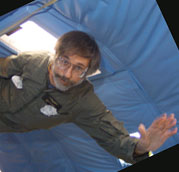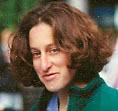
|
Dr. Mark Shelhamer received his doctoral degree in Biomedical Engineering from MIT in 1990. While there, he studied sensorimotor physiology and modeling. His research work involved the study of astronaut adaptation to space flight, including participation in two sets of Spacelab experiments carried out on the space shuttle. He then moved to Johns Hopkins where he continued the study of sensorimotor adaptation with an emphasis on the vestibular and oculomotor systems. This has included the opportunity to study adaptation to altered gravity environments (see accompany picture!) through flights in NASA's "vomit comet" parabolic-flight aircraft. In parallel with this, Dr. Shelhamer has applied nonlinear dynamical analysis to the control of eye movements, emphasizing the temporal dynamics of reflexive, reactive, and predictive control. He is the author of Nonlinear Dynamics in Physiology: A State-Space Approach, has published over 50 scientific papers, and has had research support from NIH, NSF, NASA, NSBRI, and the Whitaker Foundation.
|
|
Presentation Abstract
Ever since the pioneering work of David Robinson in the 1960s, rigorous mathematical approaches have been applied to the study of eye movements. These investigations, originally conducted by those with training in electrical engineering, continue to draw investigators from diverse fields, including physiology, psychology, neuroscience, and engineering. The work that I will describe brings to bear on oculomotor control another in a long and - mostly - successful line of mathematical approaches. After a brief review of the modern history of eye-movement research, I will move on to present my own more recent work on dynamical systems approaches to two types of eye movements: optokinetic nystagmus (OKN) and saccades.
|
|
OKN is a (mostly) reflexive eye movement that is driven by a large and homogeneous moving visual field. The resulting eye movements attempt to track the visual field in one direction with slow phases, and snap back occasionally with fast phases to foveate and track a new point. Some aspects of fast phases appear completely random while others have a correlated-noise structure. These correlations imply memory across fast phases, and I will discuss how this statistical structure can change when OKN is stimulated in different manners, which invoke different levels of reflexive and volitional control.
|
|
Saccades are rapid re-orienting eye movements that change the line of sight. Human subjects naturally generate predictive saccades when tracking periodically paced visual targets at a frequency above about 0.5 Hz, while tracking at lower frequencies produces reactive saccades. When target pacing monotonically increases or decreases, there is an abrupt transition between the two tracking modes (a phase transition), indicative of a bistable system. Several lines of evidence show that predictive saccade sequences are generated by an internal neural clock.
|
|
Reactive saccade latencies are uncorrelated and resemble white noise. Predictive saccade latencies are correlated, so that the performance of previous saccades is taken into account in the timing of subsequent saccades. These correlations are strongest over about two seconds; prediction is enabled when a sufficient number of previous saccades fall into this two-second window, so that their timing error can be monitored. This explains the transition between reactive and predictive tracking: only when target pacing is at a high enough frequency will a sufficient number of previous saccades fall into this window and allow an estimate of inter-stimulus intervals to be made.
|
|
Correlations between predictive saccades decay gradually, suggesting fractional Brownian motion (fBm), which is a hallmark of self-organizing systems and demonstrates variations on multiple time scales: trial-to-trial variations correct timing errors while slower variations reflect changing confidence in stimulus history. The longer a fixed stimulus continues, the more confidence there is in programming future behavior based on past performance. This is seen in the fact that correlations between predictive saccades increase as the pacing stimulus continues. (This also leads to hysteresis in the phase transition between reactive and predictive tracking.) I will discuss implications of these long-term correlations, and alternative explanations for their occurrence.
|
|
Another example of self-organization is the tradeoff between reliance on previous saccade performance and the current stimulus, and this weighting changes as stimulus variability increases. Thus, saccade sequences exhibit not only predictive behavior, but also the ability to modify predictive properties based on experience, another hallmark of self-organizing systems.
|

|
Dr. Deborah J. Aks received her doctoral degree from the University of British Columbia in 1993. She is a Research Associate Professor at Rutgers University. She has studied a range of topics in visual perception including the interaction of apparent depth with perceived size. Dr. Aks has also spent much time learning DS analytical techniques, and thinking about applications to various perceptual phenomena including visual search and ambiguous stimuli. She has become increasingly convinced that to understand perception we need to explore how the process unfolds and changes over time.
|
|
Presentation Abstract
The coordination of perception and cognition is intimately tied to people's interactions with their surrounding environment. This dynamic plays a crucial role in accounting for how incoming sensory information integrates with prior experience, and gives rise to efficient functioning in the real world. Critical to understanding such complex systems is the need to learn how behavioral patterns evolve over time, are time-dependent, and how they scale with surrounding context. Also essential is the need to determine the role that internal states and external conditions contribute to these behavioral patterns. Using visual search as a working example, I will discuss how dynamical systems theory and its tools can help us better understand the complex interplay between mental-behavioral-environmental systems. Specifically, I will describe how scan-paths can be used to assess patterns of correlation across a series of eye-movements. Results from various search tasks show scaling and long-range (1/f) trends across a diverse set of conditions. When display structure is altered, subtle but reliable shifts occur in search patterns: Extrinsic structure either attenuates or enhances intrinsic processes depending on which serves as the better guide to search. Despite these display-induced shifts, 1/f patterns were surprisingly pervasive across conditions suggesting a common, but highly variable, scanning strategy is used by most people across many different search settings. That this pattern occurs across the sequence of fixations is important since these are a hallmark of attention-based processes, and thus suggest a '1/f generating-mechanism' is involved in top-down cognitive processes. One significant and perhaps counterintuitive implication is that self-organizing processes may be essential to goal-driven behavior.
|

